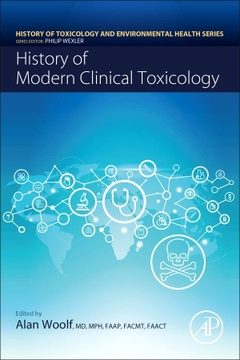Description
History of Modern Clinical Toxicology
History of Toxicology and Environmental Health Series
Coordinator: Woolf Alan
Language: English
Subject for History of Modern Clinical Toxicology:
646 p. · 15x22.8 cm · Paperback
Description
/li>Contents
/li>Biography
/li>Comment
/li>
Section 1. Disasters: Examples of toxic calamities in modern times 1.1 Triortho cresyl phosphate “Ginger Jake disaster—United States, 1930s 1.2 Three methylmercury poisoning disasters 1.3 Community dioxin disaster—Seveso, Italy, 1976 1.4 Arsenic in tube well water—Bangladesh, 1970s–1990s 1.5 Toxic oil syndrome—Spain, 1981 1.6 Eosinophilia-myalgia syndrome—United States, 1989 1.7 Methyl isocyanate—Bhopal, India, 1984 1.8 Zamfara gold mining lead poisoning disaster—Nigeria, Africa, 2010 1.9 Itai-Itai disease—Japan, 1955 1.10 Japan “Yusho poisoning, 1968 and Taiwan “Yucheng poisoning, 1979
Section 2. Notable pharmaceutical poisoning incidents and poisoned people 2.1 Sulfanilamide (diethylene glycol) disaster—United States, 1937 2.2 Gasping syndrome, 1982 2.3 Tylenol cyanide poisoning in United States, 1982 2.4 Thalidomide tragedy, 1950s 2.5 Dimethylmercury death—Professor Wetterhahn, 1996 2.6 Yushchenko (dioxin), 2004 and Markov (ricin), 1978: Two political poisonings
Section 3. Discovery of selected modern antidotes 3.1 N-Acetylcysteine 3.2 Fomepizole 3.3 Methylene blue 3.4 British anti-lewisite (dimercaprol) 3.5 Pralidoxime and oximes 3.6 Naloxone 3.7 Physostigmine 3.8 Cyanide antidotes
Section 4. Clinical toxicology and poison control in the United States 4.1 U.S. Poison Control Centers get organized: 1950s–1960s 4.2 Era of regionalization and standardization: 1970s–1980s 4.3 The information technology revolution: 1990s 4.4 New millennium, new directions: 2000–2020 4.5 Professionalism in US Clinical Toxicology—Training, practice, consultation, and societies
Section 5. Clinical toxicology and poison information in Europe, Scandinavia, and Israel 5.1 United Kingdom and Ireland 5.2 Czech Republic and other Central European and Eastern European countries 5.3 Russia 5.4 Germany 5.5 The Netherlands 5.6 Belgium 5.7 France 5.8 Spain and Portugal 5.9 Italy 5.10 Switzerland 5.11 Scandinavia 5.12 Israel 5.13 Contribution of the World Health Organization to toxicology and poisons centers 5.14 The European Association of Poisons Centres and Clinical Toxicologists (EAPCCT)
Section 6. Clinical toxicology and poison control in Asia and Australia 6.1 Australia 6.2 The Chinese mainland 6.3 Taiwan 6.4 The Philippines 6.5 Vietnam 6.6 Thailand 6.7 South Korea
- Offers descriptions of the key regulatory advances affecting clinical toxicology
- Provides synopses of modern-day poisoning disasters
- Outlines the development of modern antidotes and future directions in clinical toxicology
- Describes the origins and development of the U.S. poison control system
- Includes the origins and features of professional clinical toxicology societies from around the world
- Includes descriptions of the history of clinical toxicology and poison control in more than 35 countries
These books may interest you

Goldfrank's toxicologic emergencies 316.57 €

Mammalian Toxicology 112.17 €


